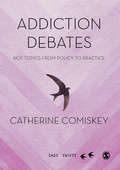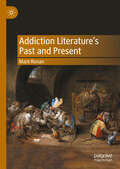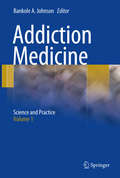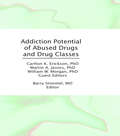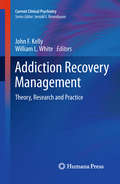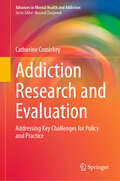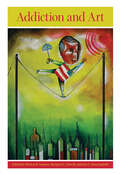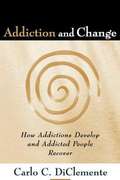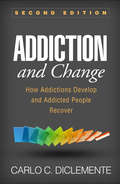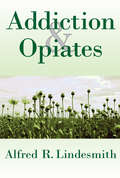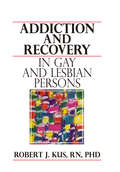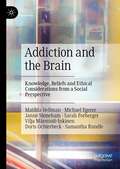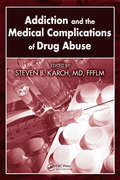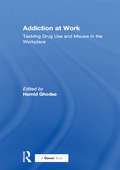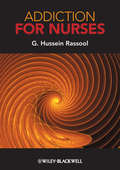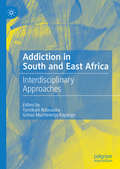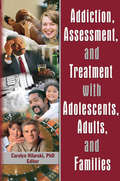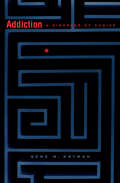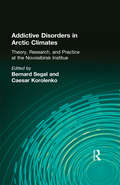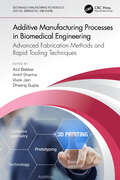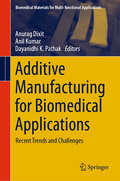- Table View
- List View
Addiction Debates: Hot Topics from Policy to Practice (SAGE Swifts)
by Catherine ComiskeyAddiction Debates explores the tumultuous landscape of addiction research, policy and practice. Covering all the ′hot topics′ of the day in a balanced and informative manner, Comiskey provides international perspectives on each topic, stimulating debate and discussion via the different approaches taken globally. Considering the complexities of debates around legalisation, rehabilitation, abstinence, harm reduction, and the current opioid epidemic, this SAGE Swift also looks into the health and social concerns related to drug consumption. Less-often debated topics include the ageing population of people who use drugs, the rights of the child of parents who use drugs, and the pressure these unique factors put on public health and associated services. A relevant text for a range of disciplines and people, sure to inform, challenge and continue the debate.
Addiction Literature's Past and Present
by Mark RonanAddiction Literature's Past and Present aims to realign consideration of addiction as a transhistorical and transcultural aspect of the human condition. This book illuminates the premodern roots of the linguistic and narrative materials of addiction discourse and argues for Addiction Literature to be considered as a distinct literary phenomenon, with a history stretching back to Antiquity. Addiction, as it is understood in this book, exists at the intersection between appetite, habit and impaired personal behavioural agency. This book begins by exploring the ways in which we articulate the experience (both lived and observed) of addiction today, uncovering a core set of conceptual components and discursive tropes which are commonly associated with modern understandings of the phenomenon. Having established a common set of tropes and features which distinguish modern Addiction Literature as a distinct literary mode, it then considers premodern texts through this lens, revealing similar patterns of conception and convention in a broad range of historical periods and literary genres from Aesop to Shakespeare.
Addiction Medicine: A Case and Evidence-Based Guide (Psychiatry Update #2)
by Jonathan D. Avery David HankinsThis book provides an accessible, up-to-date understanding of how to treat patients with substance and non-substance-related addiction. It covers all the typical substance and non-substance use disorders and presents evidence in a case-based format.Concise and comprehensive, opening chapters relay a preliminary assessment of addiction disorders and their neurobiology. Subsequent chapters then offer specific treatment options, challenges, and cases relating to the abuse of distinct substances. The substances mentioned earlier include alcohol, opioids, stimulants, hallucinogens, and sedatives. Additionally, one chapter covers the unique issues associated with treating behavioral addictions, such as sex and gambling. Each chapter will outline cases in a fashion that will optimize the reader's experience. In closing, the book examines co-occurring substance use disorders and mental illness.An invaluable addition to the Psychiatry Update Series, Addiction Medicine is an essential reference for mental health clinicians, as well as primary care and family medicine clinicians.
Addiction Medicine: Science and Practice
by Bankole A. JohnsonThe spectrum of addiction disorders presents practitioners with numerous challenges--among them the widening gap between a growing evidence base and the translation of this knowledge into treatment outcomes. Addiction Medicine addresses this disconnect, clearly explaining the role of brain function in drug taking and other habit-forming behaviors, and applying this biobehavioral framework to the delivery of evidence-based treatment. Its state-of-the-art coverage provides clinically relevant details on not only traditional sources of addiction such as cocaine, opiates, and alcohol, but also more recently recognized substances of abuse (e.g., steroids, inhalants) as well as behavioral addictions (e.g., binge eating, compulsive gambling, hoarding). Current behavioral and medical therapies are discussed in depth, and the book's close attention to social context gives readers an added lens for personalizing treatment. An international panel of expert contributors offers the most up-to-date information on: Diagnosis and classification Neurobiological and molecular theories of addiction Behavioral concepts of addiction Clinical aspects of addiction to a wide range of substances, including opiates, stimulants, sedatives, hallucinogens, alcohol, nicotine, and caffeine Science-based treatment options: pharmacotherapy, pharmacogenetics, potential vaccines, brief and compliance-enhancing interventions, cognitive behavioral treatment, behavioral management, and other psychosocial interventions Behavioral addictions--including compulsive eating, Internet messaging, and hypersexuality--and their treatment Addiction in specific populations, including adolescents, the elderly, pregnant women, and health care professionals Legal, disability, and rehabilitation issues At once comprehensive and integrative, Addiction Medicine is an essential text and a practice-expanding tool for psychiatrists, health psychologists, pharmacologists, social workers, drug counselors, trainees, and general physicians/family practitioners.
Addiction Neuroethics
by Wayne Hall Adrian CarterAddiction is a significant health and social problem and one of the largest preventable causes of disease globally. Neuroscience promises to revolutionise our ability to treat addiction, lead to recognition of addiction as a 'real' disorder in need of medical treatment and thereby reduce stigma and discrimination. However, neuroscience raises numerous social and ethical challenges: * If addicted individuals are suffering from a brain disease that drives them to drug use, should we mandate treatment? * Does addiction impair an individual's ability to consent to research or treatment? * How will neuroscience affect social policies towards drug use? Addiction Neuroethics addresses these challenges by examining ethical implications of emerging neurobiological treatments, including: novel psychopharmacology, neurosurgery, drug vaccines to prevent relapse, and genetic screening to identify individuals who are vulnerable to addiction. Essential reading for academics, clinicians, researchers and policy-makers in the fields of addiction, mental health and public policy.
Addiction Potential of Abused Drugs and Drug Classes
by Barry StimmelIncrease your awareness of the relative addiction liabilities of various drugs and drug classes that are commonly abused. A timely and masterful new book, Addiction Potential of Abused Drugs and Drug Classes clarifies, in contemporary terminology, the state of addiction liability of cocaine, opiates, alcohol, sedative-hypnotics, nicotine, anxiolytics, marijuana, inhalants and anesthetics, and PCP and hallucinogens--the nine drugs that are most abused today. Authorities combine their research expertise with the available scientific literature to evaluate those factors which contribute to the addictive qualities of drugs. Specific chapters highlight the positive and negative reinforcement qualities that make drugs rewarding, focus on the two major subtypes of alcoholics, and cover the neuroanatomical and neurochemical bases of psychological dependence, the greatest contributing factor to drug addiction. An essential new resource for scientists, clinicians, and administrators, Addiction Potential of Abused Drugs and Drug Classes also highlights those areas where more work is needed in order to understand how individual drugs affect the processes of dependence, tolerance, and addiction, so that adequate treatment of these disorders can be discovered.The book was written for teachers and researchers in the chemical dependency field, to provide an up-to-date review of the literature. In addition, physicians, nurses, and pharmacists will find the book to be valuable as an update on the relative addiction strengths of abused drugs. Finally, treatment counselors and professionals with some knowledge of physiology and pharmacology will be interested in the book because of its relevance to the clinical treatment of chemically-dependent patients.
Addiction Recovery Management: Theory, Research and Practice (Current Clinical Psychiatry)
by John F. Kelly William L. WhiteAddiction Recovery Management: Theory, Research, and Practice is the first book on the recovery management approach to addiction treatment and post-treatment support services. Distinctive in combining theory, research, and practice within the same text, this ground-breaking title includes authors who are the major theoreticians, researchers, systems administrators, clinicians and recovery advocates who have developed the model. State-of-the art and the definitive text on the topic, Addiction Recovery Management: Theory, Research, and Practice is mandatory reading for clinicians and all professionals who work with patients in recovery or who are interested in the field.
Addiction Research and Evaluation: Addressing Key Challenges for Policy and Practice (Advances in Mental Health and Addiction)
by Catherine ComiskeyAccording to the United Nations Office of Drugs and Crime, around 284 million people aged between 15 and 64 years used drugs in the year 2020. In addition, it is estimated that over 11 million people were injecting drugs and half of these were living with hepatitis C. Young people are using more drugs than previously, and numbers have increased over the past decade. While numbers are estimated at a global level, there remains little evidence for practitioners and policy makers on key questions, such as how many people are using drugs that are hidden and haven’t contacted services. Questions include the challenging topics of providing safe injecting spaces and drug consumption rooms. As populations age in some regions, questions arise on the nature of substance use among older people. Countries with younger populations are concerned about estimates on the numbers of children potentially impacted by parental substance use and how to engage with them. Awareness of trauma informed services is increasing and questions arise on the impact of domestic abuse or adverse childhood experiences on people who use drugs and their families. Globally, there is a growing concern on how to inform the debate on cannabis policies and how to assess if the chosen policy will be acceptable to the general population. The aim of this book is to provide researchers, service providers and policy makers with a step-by-step guide to robust methodologies and illustrative case studies to address these challenges. The objective of each chapter is to answer a key question, provide a summary of the background evidence, demonstrate through a series of logical steps how to obtain national or local evidence, and finally illustrate the process with detailed, real life case studies. As addiction is encountered across a wide range of professions and civil society organizations, this book will be an essential textbook for graduate students of medicine, nursing public health, addiction, psychology and health and social care professions. It will be a guiding reference book for international, national and local commissioners and providers of related policies and services. At a local level the step-by-step case studies will provide an easy to follow framework for those wishing to apply the methods to benefit and improve their own practice, service or policy.
Addiction and Art
by Patricia B. Santora Margaret L. Dowell Jack E. HenningfieldHighly Commended in Psychiatry, 2011 BMA Medical Book Awards. British Medical AssociationAddiction to alcohol, tobacco, and other drugs is one of the major public health issues of our time. It accounts for one of every five deaths in the United States and costs approximately one-half trillion dollars per year in health care expenditures and lost productivity. Its human costs are untold and perhaps uncountable. Addiction and Art puts a human face on addiction through the creative work of individuals who have been touched by it.The art included here presents unique stories about addiction. Many pieces are stark representations of life on the edge. Others are disturbing contemplations of life, meaning, and death. Some even reflect the allure of addiction and a fondness for substance abuse. A panel of addiction scientists, artists, and professionals from the art world selected the 61 pieces included here from more than 1,000 submissions. Accompanied by a written statement from the artist, each creation is emblematic of the destructive power of addiction and the regenerative power of recovery. Stunning and occasionally unsettling, this unique portfolio reveals addiction art as a powerful complement to addiction science.
Addiction and Change
by Carlo DiclementeThe stages-of-change model has become widely known as a framework for conceptualizing recovery. Less well known are the processes that drive movement through the stages or how the stages apply to becoming addicted. From Carlo C. DiClemente, codeveloper of the transtheoretical model, this book offers a panoramic view of the entire continuum of addictive behavior change. The author illuminates the common path that individuals travel as they establish and reinforce new patterns of behavior, whether they are developing an addiction or struggling to free themselves from one, and regardless of the specific addictive behavior. The book addresses crucial questions of why, when, and how to intervene to bolster recovery in those already addicted and reach out effectively to people at risk.
Addiction and Change, Second Edition: How Addictions Develop and Addicted People Recover
by Carlo C. DiClementeNot everyone who experiments with substance use or risky behavior becomes addicted, and many who are addicted have been able to recover. This authoritative book, now revised and updated, has given tens of thousands of professionals and students a state-of-the-art framework for understanding the journey both into and out of addiction. From Carlo C. DiClemente, codeveloper of the transtheoretical model (TTM), the book identifies the stages and processes involved in initiating, modifying, maintaining, or stopping any pattern of behavior. Grounded in extensive research, and illustrated with vivid case examples, the book shows how using the TTM can help overcome obstacles to change and make treatment and prevention more effective. New to This Edition *Incorporates 15 years of research advances, contemporary prevention and treatment approaches, and the ongoing development of the TTM. *Chapter on current developments in intervention research. *Expanded discussions of neuroscience; self-regulation; behavioral economics; self-help, mutual help, and spirituality; motivational issues; "process addictions" (gambling and sex addiction); and more. *Deeper coverage of risk and protective factors across adolescent and young adult development.
Addiction and Opiates
by Alfred R. LindesmithThis classic study is concerned with addiction to opiate-type drugs and their synthetic equivalents. Lindesmith proposes and systematically elaborates a rational, general theoretical account of the nature of the experiences which generate the addict's characteristic craving for drugs. While this theoretical position has obvious implications for addictions that resemble opiate addiction in that they also involve drugs which produce physical dependence and withdrawal distress, the author does not extend the theory to these other forms of addiction, such as alcoholism.The central theoretical problem is posed by the fact that some persons who experience the effects of opiate-type drugs and use them for a period sufficient to establish physical dependence do not become addicts, while others under what appear to be the same conditions do become addicted. The focus of theoretical attention is on those aspects of addiction which may reasonably he regarded as basic or essential in the sense that they are invariably manifested by all types of addicts regardless of place, time, method of use, social class, and other similar variable circumstances. Lindesmith then makes a brief statement of a view of current public policy concerning addiction in the United States reform which, it is believed, would substantially reduce the evils now associated with addiction and the large illicit traffic in drugs. He interviews approximately fifty addicts over a fairly extended period of time sufficient to establish an informal, friendly relationship of mutual trust.The attempt to account for the differential reactions among drug users requires specification of the circumstances under which physical dependence results in addiction and in the absence of which it does not. It also requires careful consideration of the meaning of "addiction," spelled out in terms of behavior and attitudes characteristic of opiate addicts everywhere. This book strives to understand these aspects of addiction with t
Addiction and Recovery in Gay and Lesbian Persons
by Robert J KusThis book provides chemical dependency clinicians a sampling of the work being done in the fields of gay and lesbian chemical dependency to enable clinicians to provide better care for their gay and lesbian clients.After an overview of 7 research studies which examine the incidence of alcoholism and/or chemical dependency in gay and lesbian persons, the contributing authors explore the special concerns of recovering gay and lesbian addicts.Chapters focus not only on issues in the fields of gay and lesbian chemical dependency but how clinicians can use this knowledge to better care for their gay and lesbian clients. Readers will find new information on: working with HIV positive persons homophobia as a critical root in chemically dependent gays and lesbians positive changes for dysfunctional relationships common with gays and lesbians spirituality in gay and lesbian communities the special needs of the rural gay/lesbian client gay men&’s groups in AA a retrospective of NALGAP resources and referrals for chemically dependent gay and lesbian personsAddiction and Recovery in Gay and Lesbian Persons assists social workers and other helping professionals working with chemically dependent clients learn more about how to adequately treat them. Gay and lesbian persons recovering from a chemical addiction will also find this book enlightening.
Addiction and the Brain: Knowledge, Beliefs and Ethical Considerations from a Social Perspective
by Michael Egerer Matilda Hellman Janne Stoneham Sarah Forberger Vilja Männistö-Inkinen Doris Ochterbeck Samantha RundleThis book investigates the neuroscientific knowledge on addiction as an epistemic project.
Addiction and the Medical Complications of Drug Abuse
by Steven B. KarchExtracted from the Drug Abuse Handbook, 2nd edition, to give you just the information you need at an affordable price.Addiction and the Medical Complications of Drug Abuse explores the physiological and psychological phenomenon of addiction including the nature of dependence, the dependence potential of drugs, and the i
Addiction at Work: Tackling Drug Use and Misuse in the Workplace
by Hamid GhodseDrugs and the workplace just don't mix. Yes, most users of illicit drugs are employed adults and there's a high correlation between levels of stress, income and alcohol abuse amongst professional and managerial employees. But the risks associated with drug use and abuse in the workplace have been well defined. Addiction at Work enables you to understand the background and extent of the problem: the cost of drug abuse to your organization; the role your own organizational culture may have in encouraging drug misuse; the risks associated with dangerous or stressful jobs. There are also chapters to help you understand the symptoms of drug abuse and the potential risks associated with perfectly legal prescription or over-the-counter medicines. The right kind of drug policy can be a significant weapon to fight this problem. So Addiction at Work explores your responsibility as an employer and how to design, communicate and implement a policy that is appropriate for your organization. Finally, there are chapters on the tools and techniques open to your organization for tackling the problem head on; ways of addressing problem behaviours; the advantages and disadvantages of drug screening and the ethics associated with this practice; employee assistance programmes and specialist care and, finally, the employment law issues around drugs. Addiction at Work has been written by some of the world-authorities on drug use in the workplace. It is an essential reference for organizations seeking a way through the human, ethical and legal issues (and the risk they present to any employer) of a social problem that is increasingly impacting employees whatever their work or the nature of their workplace.
Addiction for Nurses
by G. Hussein RassoolNurses are acknowledged as key agents in addressing alcohol and drug misuse at individual, family, and community levels. Addiction nursing is central to the assessment, management, and care of people with problematic use of psychoactive substances (both legal and illegal). Work takes place in a wide range of settings, from traditional hospital clinics and wards to community locations such as police custody suites and needle exchange facilities. Addiction for Nurses is a comprehensive textbook for students, explaining the role of the nurse at each stage of intervention. Early chapters approach the subject from sociological, historical, and cultural perspectives, covering significant topics such as the nature of addiction, its social context, and addiction theory. The book then presents vital information about each of the main areas of addiction (nicotine, alcohol, opiates, cannabis, psychostimulants, and hallucinogens) with clinical and practical guidance on recognition, assessment, and treatment intervention strategies. Further chapters consider dealing with emergencies, blood-borne viruses, harm reduction, and work with specific client groups (for instance, black and ethnic minority communities, or those with special needs). This book is an essential resource for all those who come into contact with alcohol and drug misusers and for specialist addiction nurses preparing for practice in this complex and rewarding field.
Addiction in South and East Africa: Interdisciplinary Approaches
by Grivas Muchineripi Kayange Yamikani NdasaukaThis book explores both the existence and prevalence of addiction in South and East Africa, departing from traditional assumptions about addiction in the region. The authors employ an interdisciplinary approach to understand the actual prevalence of addiction and the forms it takes in South and East Africa. The book also addresses the perceptions and conceptualisation of addiction in the region, in addition to discussing specific issues related to drug and alcohol abuse and addiction, social media addiction, and sex addiction.
Addiction in the Family: Helping Families Navigate the Challenges, Emotions, and Recovery
by Louise StangerA practical and supportive guide for families struggling with addictionGet compassionate guidance that shows you how to navigate the unique challenges faced when a family member is suffering from a substance use disorder (SUD). Addiction in the Family helps you better understand what your loved one is going through while also offering realistic advice for approaching their addiction and how it affects your entire family.Drawing on Dr. Louise Stanger's years of experience as an SUD and family trauma clinician, Addiction in the Family allows you to take things at your own pace and concentrate on the areas where you need the most help. Whether it's finding ways to help your loved one, concentrating on your own self-care, or starting the healing and recovery journey, you'll find practical and thoughtful guidance.Addiction in the Family is:Family-focused—Get advice that addresses the dynamics and challenges of dealing with a partner, child, or other family member who is suffering from SUD.Practical and hopeful—Learn how to set boundaries, deal with strong emotions, and find addiction treatment options, as well as the best ways to communicate with a loved one compassionately and honestly.Filled with real-life examples—Realize that you aren't alone thanks to composite anecdotes—drawn from Dr. Louise's practice—that help you contextualize your experiences.Addiction in the Family will help you discover a measured and considerate way to approach a family member suffering from SUD.
Addiction, Assessment, and Treatment with Adolescents, Adults, and Families
by M. Carolyn HilarskiTime-effective intervention and prevention tools for dealing with addictionAddiction, Assessment, and Treatment with Adolescents, Adults, and Families examines addiction concerns ranging from prevention to relapse, offering effective intervention techniques and assessment tools to ensure delivery of the best possible service to clients who represent a variety of populations and mental health issues. Leading addiction researchers address new developments in theory, methodology, treatment, and assessment on counselor beliefs, contingency management, group treatment, rapid assessment instruments, behavioral couples therapy (BCT), family-based intervention, motivational interviewing, and 12-step programs and faith-based recovery. This essential professional and academic resource presents case studies, reviews, research findings, and empirical papers that offer unique perspectives on a variety of topics, including evidenced-based practice, theory of reasoned action, harm reduction, juvenile justice, and treatment outcomes.Addiction, Assessment, and Treatment with Adolescents, Adults, and Families presents sophisticated, cutting-edge theory and practice concepts that provide professionals, practitioners, and educators with a more varied focus than most current available books on addiction. Counselors working in mental health settings and EAP programs, psychiatric nurses working in hospitals and outpatient settings, social workers, and students pursuing degrees in social work, nursing, psychology, and criminal justice will benefit from the book&’s wide range of appropriate addiction, treatment, and prevention methodologies.Topics addressed in Addiction, Assessment, and Treatment with Adolescents, Adults, and Families include: understanding the gap between research and practice in substance abuse counseling prevalence and patterns of illicit drug use among juvenile offenders the relationship between the reported substance abuse of African-American and Hispanic youth and their perceived attachments with their primary caregivers using a harm reduction approach to the evaluation of treatment outcomes using a nonconfrontational approach to substance abuse counseling when addressing client denial why contingency management interventions are underutilized, especially in community settings how to determine if and when Motivational Interviewing (MI) and Adapted Motivational Interviewing (AMI) are effective how to use nonabstinence-based prevention services in working with adolescents how to use and score the K6 scale to screen serious mental illnesses how to use Receiver Operating Characteristics analysis to evaluate rapid assessment instrumentsAddiction, Assessment, and Treatment with Adolescents, Adults, and Families is a vital professional resource and an invaluable aid to adults, adolescents, and families of anyone suffering with some level of addiction.
Addiction: A Disorder of Choice
by Gene M. HeymanIn a book sure to inspire controversy, Gene Heyman argues that conventional wisdom about addiction—that it is a disease, a compulsion beyond conscious control—is wrong. Drawing on psychiatric epidemiology, addicts’ autobiographies, treatment studies, and advances in behavioral economics, Heyman makes a powerful case that addiction is voluntary. He shows that drug use, like all choices, is influenced by preferences and goals. But just as there are successful dieters, there are successful ex-addicts. In fact, addiction is the psychiatric disorder with the highest rate of recovery. But what ends an addiction? At the heart of Heyman’s analysis is a startling view of choice and motivation that applies to all choices, not just the choice to use drugs. The conditions that promote quitting a drug addiction include new information, cultural values, and, of course, the costs and benefits of further drug use. Most of us avoid becoming drug dependent, not because we are especially rational, but because we loathe the idea of being an addict. Heyman’s analysis of well-established but frequently ignored research leads to unexpected insights into how we make choices—from obesity to McMansionization—all rooted in our deep-seated tendency to consume too much of whatever we like best. As wealth increases and technology advances, the dilemma posed by addictive drugs spreads to new products. However, this remarkable and radical book points to a solution. If drug addicts typically beat addiction, then non-addicts can learn to control their natural tendency to take too much.
Addictive Disorders in Arctic Climates: Theory, Research, and Practice at the Novosibirsk Institute
by Bernard SegalDiscover fresh perspectives on alcoholism treatment and research with this enlightening new book describing the work of researchers at the Novosibirsk Medical Institute, USSR. By using specific examples of their studies in Siberia, the reserachers offer an innovative approach to the treatment of addictive disorders in general. Instead of focusing on the drinking behavior itself, the treatment focuses on the relation of the problem to the interaction of economic, social, and psychological factors. To address the question of whether alcoholics should all be treated in the same way, or if alcholism treatment should be more individualized in approach, chapters are devoted to the differences between alcoholism in women, adolescents, and alchoholics who are afflicted with “rapid development of alcholism syndrome.” The research examples in Addictive Disorders in Arctic Climates benefits professionals involved in the treatment of alcholism by introducing new perspectives and broadening contemporary research.
Additive Manufacturing Processes in Biomedical Engineering: Advanced Fabrication Methods and Rapid Tooling Techniques (Sustainable Manufacturing Technologies)
by Ankit Sharma Vivek Jain Atul Babbar Dheeraj GuptaThis book covers innovative breakthroughs in additive manufacturing processes used for biomedical engineering. More and more, 3D printing is selected over traditional manufacturing processes, especially for complex designs, because of the many advantages such as fewer restrictions, better production cost savings, higher quality control, and accuracy. Current challenges and opportunities regarding material, design, cost savings, and efficiency are covered along with an outline of the most recent fabrication methods used for converting biomaterials into integrated structures that can fit best in anatomy while still obtaining the necessary architecture, mechanical reliability, biocompatibility, and anti-bacterial characteristics needed. Additional chapters will also focus on selected areas of applications such as bionics, affordable prostheses, implants, medical devices, rapid tooling, and drug delivery. Additive Manufacturing Processes in Biomedical Engineering: Advanced Fabrication Methods and Rapid Tooling Techniques acts as a first-hand reference for commercial manufacturing organizations which are mimicking tissue organs by using additive manufacturing techniques. By capturing the current trends of today’s manufacturing practices this book becomes a one-stop resource for manufacturing professionals, engineers in related disciplines, and academic researchers.
Additive Manufacturing for Biomedical Applications: Recent Trends and Challenges (Biomedical Materials for Multi-functional Applications)
by Anil Kumar Anurag Dixit Dayanidhi K. PathakNew fabrication techniques and biomaterials have advanced significantly as attention toward healthcare innovations in recent decades has increased. This book provides a comprehensive overview of the application of additive manufacturing for biomedical devices. The book focuses on the use of biomaterial for hard and soft tissue engineering. These materials can imitate the mechanical, structural, and biological characteristics of the parent tissue, repairing or replacing its functioning. It provides details on the use of various biomaterials for different biomedical applications. It highlights the present trends and potential of various techniques and materials for various applications. The chapters in this book written by eminent experts highlight recent developments in additive manufacturing for biological mimicking and surgical planning. It discusses latest advances in various 3D printing technologies in the fabrication of biomedical devices for orthopaedic and cardiovascular applications, along with rising trends in designing and creating tissue replacement substitute simulants. This book can serve as a fundamental textbook for research in additive manufacturing, fabrication of implants or scaffolds and medical device development, biomaterials, tissue engineering, and biomedical engineering. This book can be a valuable resource for mechanical and biomedical engineers, academicians, healthcare researchers, and professionals interested in tissue engineering.
Additive Manufacturing in Multidisciplinary Cooperation and Production (Springer Tracts in Additive Manufacturing)
by Igor Drstvensek Snehashis Pal Nataša Ihan HrenThis book publishes the latest findings and ideas in the field of additive manufacturing presented by authors from prominent institutions around the world at the iCAT 2023 conference. The authors address various technological and medical aspects, ranging from materials science to the specific behaviour of the technology under different working conditions. The book is divided into four sections, three of which are dedicated to the purely technological aspects of additive manufacturing, covering metal processes, polymer processes and simulation. The fourth part of the book is dedicated to the medical applications of additive manufacturing, covering areas ranging from orthopaedic surgeries to materials used in medical AM.Overall, the book provides insight into the current state of the science and applications of additive manufacturing.
